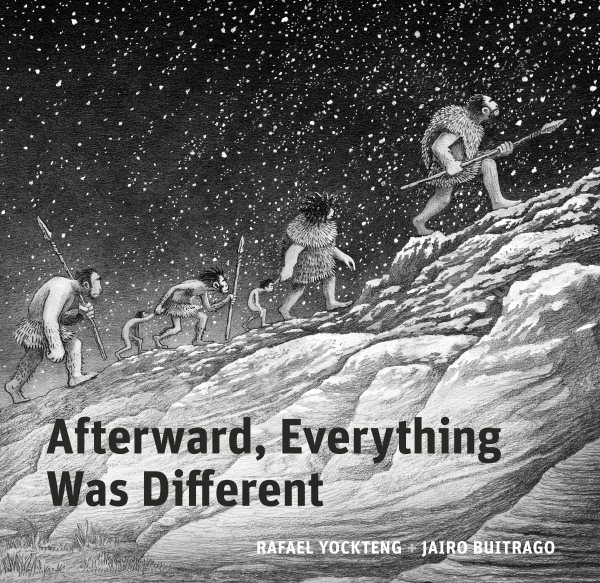 Afterward, Everything Was Different: A Tale from the Pleistocene
Afterward, Everything Was Different: A Tale from the Pleistocene
Written by Jairo Buitrago
Illustrated by Rafael Yockteng
Translated by Elisa Amado
Aldana Libros/Greystone Kids , 2023, 60 pp (unpaged)
ISBN: 9781778400605
“Somewhere between two and a half million and ten thousand years ago, in the era we now call the Pleistocene, small groups of people traveled around their known world, hunting for food, seeking shelter, and slowly becoming more like the people we are today” (Authors’ Note). This stunningly illustrated, mostly wordless book imagines how art and storytelling emerged from one young girl’s keen observations during the Pleistocene era. The book begins before the copyright and title pages with six double-page graphite sketches depicting a bison hunt, volcano eruptions, Eremotherium Rusconi (ground sloths), people with long spears, and challenges of the time.
The story follows a Pleistocene-era group of human families as they explore and walk the land, seeking food and shelter. Readers will quickly notice that one child in particular pays attention to details that the rest seem to overlook. She notices a giant footprint, a sea animal posing an imminent threat to an individual taking a nap, a starry night, and a tree tall enough for people to climb to avoid land predators. When the group finds a cave large enough to shelter everyone, this child creates lasting marks on stone to tell her people’s stories.
Originally written in Spanish and published in Colombia, this intricate book has strong potential for inquiry and dialogue. For example, some readers may make connections to science-related concepts like human beings or evolution. However, they will notice that the author’s text in the back seems to have intentionally opted for words that offer a broader narrative about people and becoming, a strategy that can encourage explorations and conversations around the non-fictional details that inspired the story.
A second point of interest may be that the gender of the child protagonist is neutral throughout the story. Yet, the author’s notes include the pronouns she and her. Readers may wonder if the authors depicted a young girl to provide an alternative perspective to stories about the Pleistocene era, which traditionally highlight the importance of males’ physical strength for survival. In this counternarrative, readers are introduced to a young girl, whose ability and willingness to create, share, and preserve stories will eventually lead her to become the clan leader (Authors’ Note). The decision to highlight a child character in this era should also be noted because it positions children’s curiosity, inventiveness, and storytelling as important resources for survival, but also for community transformation.
Last but not least, the gorgeous black and white drawings in graphite and white ink on lilac 104 Canson paper encourage readers to be as observant as the child in the story. Yockteng’s meticulous shading, dramatic use of scale, and humoristic tone depict the family’s interactions with their environment, encouraging readers to explore the joys, dangers, and family dynamics of Pleistocene life. From human feet under a massive rock, to a giant bearlike creature turned into a rug, the illustrations captivate readers instantly. Readers also feel compelled to investigate how the child was able to draw on the stone with a stick. As such, they find themselves revisiting the illustrations (including the endpapers!) and rereading the author’s notes to find the answers.
With regards to the theme of this issue around human invention, Afterward, Everything Was Different explores the act of creating and preserving pictorial representations and stories (writing) as an innovation that changed people’s history. This book can be read alongside other stories that highlight the human need to record history through stories, in books such as I Am a Story by Dan Yaccarino (2016), or Dia’s Story Cloth: The Hmong People’s Journey of Freedom by Dia Cha and illustrated by Chue and Nhia Thao Cha (1996). Additional pairing possibilities could be informational books about the Pleistocene era like Stone Age Beasts by Ben Lerwill and illustrated by Grahame Baker-Smith (2023).
Jairo Buitrago is an award-winning Colombian children’s books author. He is also a researcher of children’s literature and film history. Rather than writing about princesses and dragons, Buitrago’s stories address complex themes such as immigration, violence, wars, and exile (Ramirez, 2018). His books have been translated into English, Portuguese, Catalan, Chinese, Turkish, Japanese, Korean, and Swedish. Buitrago and Yockteng have collaborated on many picturebooks, such as Jimmy the Greatest! (2012), Two White Rabbits (2015), Walk with Me (2017), and Lion and Mouse (2019).
Rafael Yockteng is a Peruvian children’s books illustrator raised in Colombia. His books address social issues rarely present in children’s literature. Recently he has collaborated with the Ministerio de Educación de Colombia facilitating art workshops for children and educators in Indigenous communities and underserved communities in rural regions of the country.
Elisa Amado is a Guatemalan-born author and translator. She translated Afterward, Everything Was Different from its original Spanish title ¡Ugh! Un relato del pleistoceno. Amado, Yockteng, and Buitrago have book titles listed on the annual award list of the United States Board on Books for Young People, the Outstanding International Books List.
References
Ramirez, C. (2018). El arte de ilustrar la violencia latinoamericana para niños. El Universal. Retrieved from https://www.eluniversal.com.mx/cultura/letras/el-arte-de-ilustrar-la-violencia-latinoamericana-para-ninos/
María Acevedo-Aquino, Texas A&M San Antonio
© 2024 by María V. Acevedo-Aquino

WOW Review, Volume XVI, Issue 4 by Worlds of Words is licensed under a Creative Commons Attribution-NonCommercial-ShareAlike 4.0 International License. Based on work by María V. Acevedo-Aquino at https://wowlit.org/on-line-publications/review/xvi-4/3/
WOW review: reading across cultures
ISSN 2577-0527
